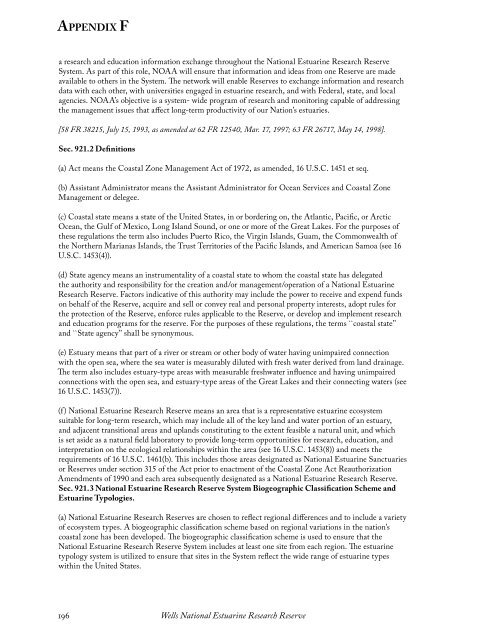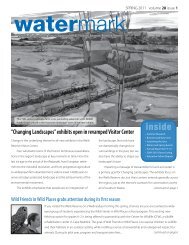Management Plan - National Estuarine Research Reserve System
Management Plan - National Estuarine Research Reserve System
Management Plan - National Estuarine Research Reserve System
You also want an ePaper? Increase the reach of your titles
YUMPU automatically turns print PDFs into web optimized ePapers that Google loves.
Appendix Fa research and education information exchange throughout the <strong>National</strong> <strong>Estuarine</strong> <strong>Research</strong> <strong>Reserve</strong><strong>System</strong>. As part of this role, NOAA will ensure that information and ideas from one <strong>Reserve</strong> are madeavailable to others in the <strong>System</strong>. The network will enable <strong>Reserve</strong>s to exchange information and researchdata with each other, with universities engaged in estuarine research, and with Federal, state, and localagencies. NOAA’s objective is a system- wide program of research and monitoring capable of addressingthe management issues that affect long-term productivity of our Nation’s estuaries.[58 FR 38215, July 15, 1993, as amended at 62 FR 12540, Mar. 17, 1997; 63 FR 26717, May 14, 1998].Sec. 921.2 Definitions(a) Act means the Coastal Zone <strong>Management</strong> Act of 1972, as amended, 16 U.S.C. 1451 et seq.(b) Assistant Administrator means the Assistant Administrator for Ocean Services and Coastal Zone<strong>Management</strong> or delegee.(c) Coastal state means a state of the United States, in or bordering on, the Atlantic, Pacific, or ArcticOcean, the Gulf of Mexico, Long Island Sound, or one or more of the Great Lakes. For the purposes ofthese regulations the term also includes Puerto Rico, the Virgin Islands, Guam, the Commonwealth ofthe Northern Marianas Islands, the Trust Territories of the Pacific Islands, and American Samoa (see 16U.S.C. 1453(4)).(d) State agency means an instrumentality of a coastal state to whom the coastal state has delegatedthe authority and responsibility for the creation and/or management/operation of a <strong>National</strong> <strong>Estuarine</strong><strong>Research</strong> <strong>Reserve</strong>. Factors indicative of this authority may include the power to receive and expend fundson behalf of the <strong>Reserve</strong>, acquire and sell or convey real and personal property interests, adopt rules forthe protection of the <strong>Reserve</strong>, enforce rules applicable to the <strong>Reserve</strong>, or develop and implement researchand education programs for the reserve. For the purposes of these regulations, the terms ``coastal state’’and ``State agency’’ shall be synonymous.(e) Estuary means that part of a river or stream or other body of water having unimpaired connectionwith the open sea, where the sea water is measurably diluted with fresh water derived from land drainage.The term also includes estuary-type areas with measurable freshwater influence and having unimpairedconnections with the open sea, and estuary-type areas of the Great Lakes and their connecting waters (see16 U.S.C. 1453(7)).(f) <strong>National</strong> <strong>Estuarine</strong> <strong>Research</strong> <strong>Reserve</strong> means an area that is a representative estuarine ecosystemsuitable for long-term research, which may include all of the key land and water portion of an estuary,and adjacent transitional areas and uplands constituting to the extent feasible a natural unit, and whichis set aside as a natural field laboratory to provide long-term opportunities for research, education, andinterpretation on the ecological relationships within the area (see 16 U.S.C. 1453(8)) and meets therequirements of 16 U.S.C. 1461(b). This includes those areas designated as <strong>National</strong> <strong>Estuarine</strong> Sanctuariesor <strong>Reserve</strong>s under section 315 of the Act prior to enactment of the Coastal Zone Act ReauthorizationAmendments of 1990 and each area subsequently designated as a <strong>National</strong> <strong>Estuarine</strong> <strong>Research</strong> <strong>Reserve</strong>.Sec. 921.3 <strong>National</strong> <strong>Estuarine</strong> <strong>Research</strong> <strong>Reserve</strong> <strong>System</strong> Biogeographic Classification Scheme and<strong>Estuarine</strong> Typologies.(a) <strong>National</strong> <strong>Estuarine</strong> <strong>Research</strong> <strong>Reserve</strong>s are chosen to reflect regional differences and to include a varietyof ecosystem types. A biogeographic classification scheme based on regional variations in the nation’scoastal zone has been developed. The biogeographic classification scheme is used to ensure that the<strong>National</strong> <strong>Estuarine</strong> <strong>Research</strong> <strong>Reserve</strong> <strong>System</strong> includes at least one site from each region. The estuarinetypology system is utilized to ensure that sites in the <strong>System</strong> reflect the wide range of estuarine typeswithin the United States.196 Wells <strong>National</strong> <strong>Estuarine</strong> <strong>Research</strong> <strong>Reserve</strong>




